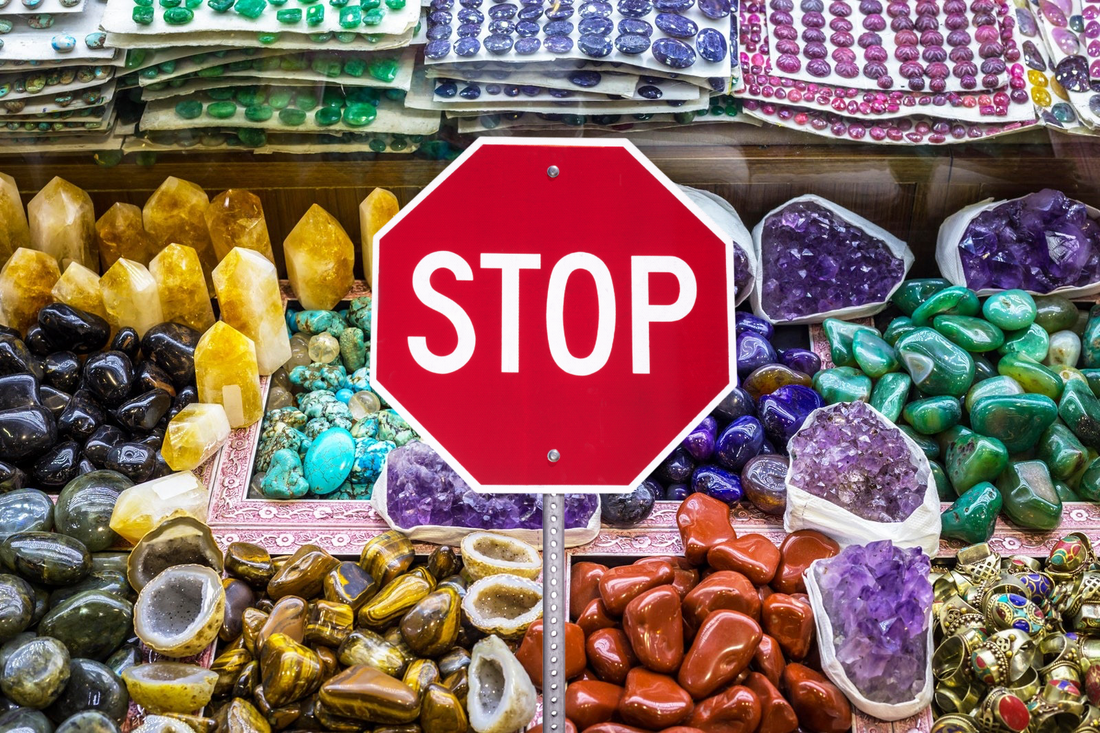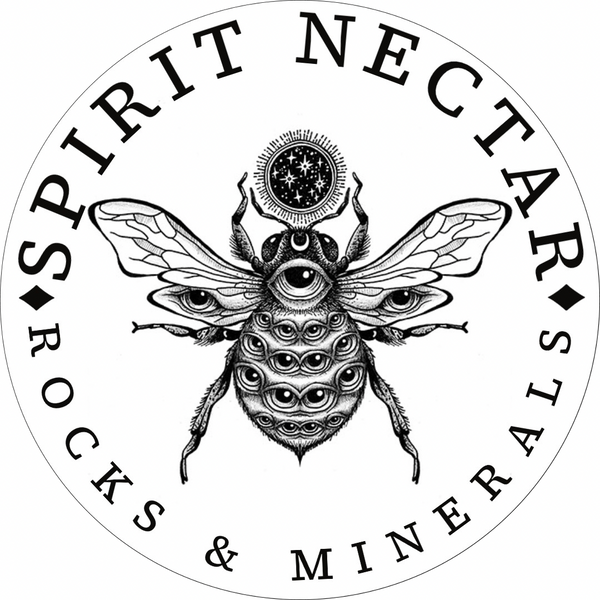
Crystal Shop Red Flags: Avoid stores with these bad practices!
Share
We've all made regrettable purchases at some point in our lives, and it stings a little more when we realize we've been taken advantage of. Questionable sellers are a part of every industry, and the realm of crystals is no exception when it comes to scams and shady practices. This list will go through a handful of red flags to watch out for when shopping for crystals, so that you can spot shady shops more easily.
#1 Shops that offer certificates of authenticity on cheap stones
A certificate of authenticity is a document that states a certified gemologist has taken a look at that exact specimen, and had deemed that it is in fact authentic. Sounds great, right? But here's the catch, it must first be sent into a gemological institute for inspection, and this costs between $50 - $150 per stone. Legitimate certificates cannot be granted for batches, only singular pieces. Even if a shop has a gemologist on their team, certificates are generally only provided for items in the ranges worth thousands of dollars. Furthermore, it is frowned upon in the industry to provide your own certifications, rather than sending the stone to an established institute. If you see certificates being offered with cheap stones, it is extremely likely to be a fake gimmick.

Here is a prime example of a fake certificate. I actually purchased this moldavite on purpose, so that I could do a video on fake moldavite for social media. This 5 gram piece only cost me $20 including shipping (the average cost for genuine moldavite this size is over $100), and the seller boasted that it comes with a certificate and a serial number that can be checked on the website. The website however, has nowhere to look up serial numbers, and has just 2 whole pages in its entirety, stating that it is a gemmology institute in India that grants certifications. I now own a very fake moldavite with a shiny certificate, so that you don't have to make this mistake.
We do have genuine Moldavite available here if you are looking for a reliable shop! Sourced directly from the mine in Chlum, Czech Republic.
#2 Shops that do not know the origins of their minerals
It's hard to trust a seller who doesn't know where their own products come from, or are reluctant to share the origins. It shows a lack of knowledge, and could mean that the seller is unaware of any treatments or other enhancements that may have been done to the stone. When a store lists the localities of their minerals, it is far more likely that they are aware of the steps those pieces have taken through the supply chain before reaching them.

Here I am inspecting stones from a local dealer in the Erongo Region, Namibia.
#3 Shops that sell "monatomic andara crystals"
Andara "crystals" are probably one of the most outrageous and mind boggling scams out there in the gem industry. They're often described as a "high vortex monatomic mineral", found near Mount Shasta in California. Sound like gibberish? That's because it is, but that doesn't stop this worthless glass being sold for hundreds to thousands of dollars to unsuspecting customers. They're usually given ridiculous names that allude to their supposed spiritual powers. The reality is, that these are just a byproduct of industrial glass production, which has been proven through chemical analysis showing elements only present in artificial glass production. While they are pretty, it would be unwise to trust any shop marketing these as authentic crystals or minerals, or even as a naturally occuring glass.

You can have your very own "andara crystal" for the low price of $17,905 - what a deal! I know it seems comical, but this Etsy shop has over 9000 sales, and thousands of reviews. Sadly this scam is still alive and well.
#4 Shops that sell crystal pipes and water bottles
These might seems like a good idea, but there are various problems that arise when we are using minerals for a purpose that involves ingesting or inhaling things. For starters, to get that shiny finish, minerals are processed with polishing compounds, oils, waxes, and other sealants. To create the stem of a crystal pipe, the material must be drilled, which can leave behind tiny dust particles. Depending on the mineral used, this could include silica, asbestos, copper, and other elements that don't belong in your lungs.

That goes for your drinking water too! Some of the common polishing compounds used include cerium oxide, tin oxide, and chromium oxide. These chemicals get trapped in microscopic cracks on the crystal's surface, so they are unlikely to simply wash off with a rinse. Instead, these will slowly leach into your water over time. Sellers offering these types of products do not have your health and wellbeing in mind! If you must have a crystal water bottle, opt for one with a separated compartment that does not come into contact with the crystals.

Here is a particularly bad offender, note the dyed howlite point, fluorite, and lapis lazuli, which besides the aforementioned issues, should not be going into your body at all!
#5 Shops that claim crystals can aid in healing physical diseases
There's no doubt that the belief in crystal healing and metaphysical properties has helped a lot of people. The placebo effect has been thoroughly proven through scientific studies after all. It is however, extremely dangerous and irresponsible when sellers market minerals as being able to cure diseases and other health problems. A shop doing this, is just taking advantage of desperation and unfortunate circumstances to make a profit.

Here is a set of tumbled stones on Amazon being specifically marketed as having "a specific focus on on energetically strengthening and supporting the body against cancer". Sellers like this truly give the crystal industry a bad name.
#6 Shops that label easily identifiable minerals incorrectly
There are over 5000 known minerals on Earth, so it's not always easy to get our identification spot on, but a crystal dealer should absolutely know the basics. Furthermore, incorrect labeling indicates that the seller does not know much about their own product, or are trying to misrepresent it as something more expensive. A common one you will often see, is blue calcite being labelled as celestite. The two look nothing alike, even in polished form, yet sellers will try to pass off the inexpensive blue calcite as celestite.

Image above shows polished blue calcite

Image above shows polished celestite, note the clarity. Celestite is incredibly difficult to polish due to its cleavage, polished pieces are almost always small in size, and far more expensive compared to blue calcite of the same size.
#7 Shops that do not disclaim treatments or other artificial enhancements
Customers should always be made aware of any treatments or enhancements done to the crystals. If you see lab grown or treated minerals being sold without any kind of disclaimer in the product description, it is unlikely that this is an honest seller. Treated minerals aren't always easy to spot, but if you notice obvious things like aura quartz, lab grown quartz, and dyed howlite, without a description explaining the treatment: it's best to be weary of this shop's other products. Examples below:

Aura quartz refers to natural quartz that has been coated with a thin layer of metals, and often dyes. The expensive version of this process uses vapour deposition to bond metals such as gold, titanium, or silver to the surface of the crystal, resulting in various colors and a rainbow shimmer. Inexpensive versions of aura crystals use dyes to color the crystal first, and then coat it with a titanium mixture to produce the iridescent sheen (as shown in the photo above).

Dyed howlite and magnesite are treated to mimic the appearance of natural turquoise. These two minerals are very soft and porous, which makes them perfect for accepting dyes easily. A deep scratch will usually reveal the original white color of the magnesite or howlite underneath, as the dye does not penetrate through the entire stone.

Pictured here is a lab grown quartz crystal, that is often marketed as "natural phantom quartz with citrine". A telltale sign of lab grown quartz, is perfect clusters with tiny crystals concentrated on the bottom. These types of clusters can be found in just about any color, so be cautious when a cluster looks a little too perfect.
Navigating the extensive amount of shops on the mineral market can be a daunting task, but with this article you should be well prepared in spotting dealers that are less than trustworthy. As always we are happy to provide you with amazing minerals and sourcing transparency, but if you are looking elsewhere, I hope this list of red flags will be helpful to you!
